Related Research Articles

In mathematics, two quantities are in the golden ratio if their ratio is the same as the ratio of their sum to the larger of the two quantities. Expressed algebraically, for quantities and with , is in a golden ratio to if

Fibonacci, also known as Leonardo Bonacci, Leonardo of Pisa, or Leonardo Bigollo Pisano, was an Italian mathematician from the Republic of Pisa, considered to be "the most talented Western mathematician of the Middle Ages".

Fractal art is a form of algorithmic art created by calculating fractal objects and representing the calculation results as still digital images, animations, and media. Fractal art developed from the mid-1980s onwards. It is a genre of computer art and digital art which are part of new media art. The mathematical beauty of fractals lies at the intersection of generative art and computer art. They combine to produce a type of abstract art.
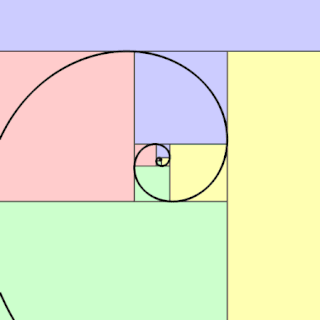
In geometry, a golden spiral is a logarithmic spiral whose growth factor is φ, the golden ratio. That is, a golden spiral gets wider by a factor of φ for every quarter turn it makes.
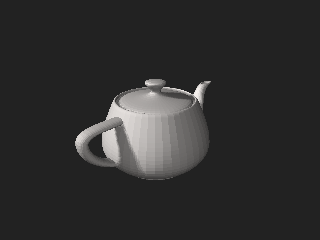
The Utah teapot, or the Newell teapot, is a 3D test model that has become a standard reference object and an in-joke within the computer graphics community. It is a mathematical model of an ordinary Melitta-brand teapot that appears solid with a nearly rotationally symmetrical body. Using a teapot model is considered the 3D equivalent of a "Hello, World!" program, a way to create an easy 3D scene with a somewhat complex model acting as the basic geometry for a scene with a light setup. Some programming libraries, such as the OpenGL Utility Toolkit, even have functions dedicated to drawing teapots.

A tessellation or tiling is the covering of a surface, often a plane, using one or more geometric shapes, called tiles, with no overlaps and no gaps. In mathematics, tessellation can be generalized to higher dimensions and a variety of geometries.

In botany, phyllotaxis or phyllotaxy is the arrangement of leaves on a plant stem. Phyllotactic spirals form a distinctive class of patterns in nature.
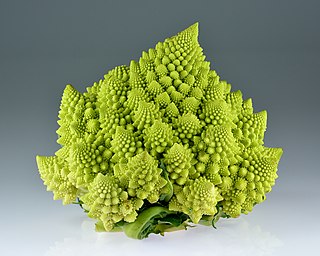
Romanesco broccoli is in fact a cultivar of the cauliflower, not a broccoli. It is an edible flower bud of the species Brassica oleracea, which also includes regular broccoli and cauliflower. It is chartreuse in color and has a striking form that naturally approximates a fractal. Romanesco has a nutty flavor and a firmer texture than white cauliflower or broccoli when cooked.

3D computer graphics, sometimes called CGI, 3-D-CGI or three-dimensional computer graphics, are graphics that use a three-dimensional representation of geometric data that is stored in the computer for the purposes of performing calculations and rendering digital images, usually 2D images but sometimes 3D images. The resulting images may be stored for viewing later or displayed in real time.
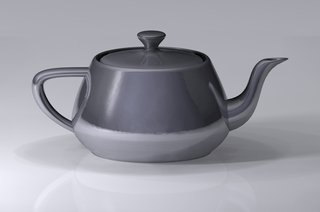
Computer graphics is a sub-field of computer science which studies methods for digitally synthesizing and manipulating visual content. Although the term often refers to the study of three-dimensional computer graphics, it also encompasses two-dimensional graphics and image processing.

Computer graphics deals with generating images and art with the aid of computers. Computer graphics is a core technology in digital photography, film, video games, digital art, cell phone and computer displays, and many specialized applications. A great deal of specialized hardware and software has been developed, with the displays of most devices being driven by computer graphics hardware. It is a vast and recently developed area of computer science. The phrase was coined in 1960 by computer graphics researchers Verne Hudson and William Fetter of Boeing. It is often abbreviated as CG, or typically in the context of film as computer generated imagery (CGI). The non-artistic aspects of computer graphics are the subject of computer science research.

Mathematical beauty is the aesthetic pleasure derived from the abstractness, purity, simplicity, depth or orderliness of mathematics. Mathematicians may express this pleasure by describing mathematics as beautiful or describe mathematics as an art form, or, at a minimum, as a creative activity.

Mathematics and art are related in a variety of ways. Mathematics has itself been described as an art motivated by beauty. Mathematics can be discerned in arts such as music, dance, painting, architecture, sculpture, and textiles. This article focuses, however, on mathematics in the visual arts.

In 3D computer graphics, 3D modeling is the process of developing a mathematical coordinate-based representation of a surface of an object in three dimensions via specialized software by manipulating edges, vertices, and polygons in a simulated 3D space.

Patterns in nature are visible regularities of form found in the natural world. These patterns recur in different contexts and can sometimes be modelled mathematically. Natural patterns include symmetries, trees, spirals, meanders, waves, foams, tessellations, cracks and stripes. Early Greek philosophers studied pattern, with Plato, Pythagoras and Empedocles attempting to explain order in nature. The modern understanding of visible patterns developed gradually over time.

The Garden of Archimedes is a museum for mathematics in Florence, Italy, founded in 2004. It has been compared to the National Museum of Mathematics in New York City, the only museum in North America devoted to mathematics.
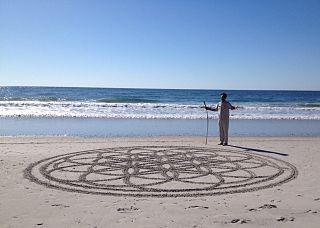
Vandorn Hinnant is a visual artist, poet and educator based in Durham, North Carolina.

Antonio Peticov is a Brazilian painter, designer, sculptor, and engraver.

Henry Segerman is an Associate Professor of mathematics at Oklahoma State University in Stillwater, Oklahoma who does research in three-dimensional geometry and topology, especially three-manifolds, triangulations and hyperbolic geometry.
Edmund Orme Harriss is a British mathematician, writer and artist. Since 2010 he has been at the Fulbright College of Arts & Sciences at The University of Arkansas in Fayetteville, Arkansas where he is an Assistant Professor of Arts & Sciences (ARSC) and Mathematical Sciences (MASC). He does research in the Geometry of Tilings and Patterns, a branch of Convex and Discrete Geometry. He is the discoverer of the spiral that bears his name.
References
- ↑ "John Edmark | San José Museum of Art". sjmusart.org. October 2, 2014. Retrieved December 23, 2023.
- ↑ Wallace, Rebecca. "From the studio to the gallery". www.paloaltoonline.com. Retrieved December 23, 2023.
- ↑ "John Edmark". issuu. Retrieved December 23, 2023.
- 1 2 "The Infinite 3D Sculptures of John Edmark". Art of Play. Retrieved December 23, 2023.
- ↑ "John Edmark | Product Realization Lab". productrealization.stanford.edu. Retrieved December 23, 2023.
- ↑ "John Edmark". Riyadh Art. Retrieved December 23, 2023.
- ↑ Jobson, Christopher (May 5, 2017). "Creating The Never-Ending Bloom: The Amazing Mathematical Wonders of John Edmark". Colossal. Retrieved December 23, 2023.
- ↑ "John Edmark's Mathematical Sculptures". National Math Festival. November 20, 2020. Retrieved December 23, 2023.
- ↑ "Flourish (Bloom)". Exploratorium.
- ↑ "The Helicone: Science or Art? Plenty of Both" . Retrieved December 23, 2023.
- ↑ Arnold, Caitlin, The Big, Complicated Process of John Edmark’s Intriguing and Beautiful Bloom Spirals , retrieved December 23, 2023